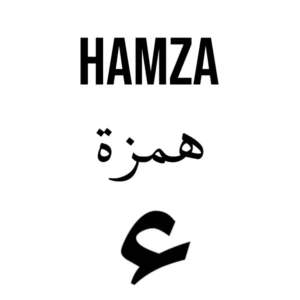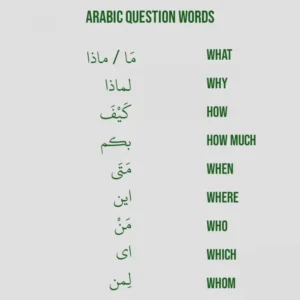Conjunction In Arabic: A Quick And Easy Guide

Conjunctions are an important part of Arabic grammar. They are words that connect two phrases, clauses, or sentences to make ideas flow smoothly.
In this lesson, we will look at some Arabic conjunctions, with examples and meanings.
Conjunctions in Arabic
In Arabic, the word for conjunctions is حُرُوْف العَطْف (huruf al-‘aṭf). This term means “joining letters” and refers to words that connect other words or parts of a sentence.
There are different types of conjunctions in Arabic, each with a specific purpose. The most common type is the coordinating conjunction, which connects two equally important clauses or sentences.
Examples of coordinating conjunctions include وَ (wa) meaning “and,” أَوْ (aw) meaning “or,” and إِلَّا (illā) meaning “except.”
For example, the sentence “الطعام جيد و الخدمة رائعة” (The food is good and the service is excellent) uses the conjunction وَ (wa) to connect two equally important ideas.
Arabic Conjunctions List
Here is the list of most common conjunction in Arabic with their meanings in English.
| Arabic Conjunction | English Meaning |
| وَ | And |
| ثُمَّ | Later, Then Later |
| أَمْ | Or |
| أَوْ | Or |
| لا | Not, (Neither) Nor |
| لكِنْ | But |
| بَلْ | Rather, More Accurately |
| حَتّى | Even |
RELATED: Vowels In Arabic: All Short And Long Arabic Vowels
1. And in Arabic: وَ
The Arabic word for “and” is وَ (wa). It is the most common conjunction in Arabic.
وَ is used to join two things, people, or actions that occur together or at the same time, as in these examples:
وَ is a simple way to connect things. It’s used to link two things without specifying the order in which they happen.
For example, in the sentence جاءَ زَيْدٌ وَخالِدٌ (Zaid and Khalid came), وَ doesn’t indicate who came first. Zaid might have come first, or Khalid might have.
When mentioning two things, it’s common to start with the one that is more important.
Examples:
- Muhammad and Ali came: جاءَ مُحَمَّدٌ وَعَلِيٌّ
- The book and the notebook are on the table: الكِتَاب والدَّفْتَر فَوْق الطَّاوِلَة
- Muhammad and Ali went: ذَهَبَ مُحَمَّد وَعَلِي
2. Then, So in Arabic: فَـ
The Arabic word for “so” or “then” is فَـ (fa). It is used to show the order in which two things happen or to express a result.
فَـ shows that one thing follows another immediately or as a consequence.
Examples:
- The student worked hard, so he succeeded: اِجْتَهَدَ الطَّالِب فَـنَجَحَ
- Read the story, then the novel: اِقْرَأ القِصَّة فَـالرِّوَايَة
- We ate the salad, then the meat: أَكَلْنَا السَّلَطَة فَـاللَّحْم
3. Later, Then Later: ثُمَّ
The Arabic word for “later” or “a while after” is ثُمَّ (thumma). It is used to show that one event happens after a delay.
ثُمَّ is used to indicate that something occurs after a certain time or delay.
Examples:
- Sarah went, then later Muhammad: ذهبت سارة ثم محمد
- I did the homework, then later I watched TV: كَتَبْتُ الوَاجِب ثُمَّ شَاهَدتُ التِّلْفَاز
- I saw my friend, then I went home: رَأَيْتُ صَدِيقِي ثُمَّ ذَهَبْتُ إِلَى الْبَيْت
4. Not, (Neither) Nor: لا
The Arabic word for “not” and “neither… nor” is لا (lā). It is used to negate what follows it, as well as to connect two nouns in a negative sentence.
لا is used to show that something is not true for both parts of the sentence. When used after وَ (wa), it emphasizes negation rather than connecting ideas.
Examples:
- Bakr came, not Khalid: جاءَ بَكْرٌ لا خَالِدٌ
- Muhammad went out, not Ali: خَرَجَ مُحَمَّدٌ لا عَلِيٌّ
- The patient didn’t eat, nor did he drink: مَا أَكَلَ المَرِيضُ وَلا شَرِبَ
5. Or: أَوْ
The Arabic word for “or” is أَوْ (aw). It can be used to:
- Offer a choice between options: تَزَوَّجْ هَنْدًا أَوْ أُخْتَهَا (Marry Hind or her sister) – You can choose to marry Hind or her sister, but not both.
- Provide feasible options, allowing for both: ادْرُسِ الْفِقْهَ أَوِ النَّحْوَ (Study fiqh or grammar) – You can study either or both.
- Show doubt between options: قَدِمَ زَيْدٌ أَوْ عَمْرٌ (Zayd or ‘Amr arrived) – Uncertain if Zayd or ‘Amr arrived.
6. Or: أَمْ
The Arabic word for “or” in a question is أَمْ (am). It is used to offer choices and ask for a specific answer after asking a question with أ (a).
Examples:
- Did you study fiqh or grammar? أَدَرَسْتَ الْفِقْهَ أَمِ النَّحْوَ؟
- Did you drink water or juice? أَشَرِبْتَ مَاءً أَمْ عَصِيرًا؟
- Is Khalid at home or Sami? أَخَالِدٌ فِي الْبَيْتِ أَمْ سَامِي؟
7. Even: حَتَّى
The Arabic word for “even” is حَتَّى (ḥattā). It is used to show that something applies to everyone, including those who are usually excluded, and can indicate a future action.
Examples:
- People will die, even the prophets: يَمُوتُ النَّاسُ حَتَّى الْأَنْبِيَاءُ
- The people sat down, even the king: جَلَسَ النَّاسُ حَتَّى الْمَلِكُ
- The students failed, even Ali (who is the best): رَسِبَ الطُّلابُ حَتَّى عَلِيٌّ
8. Rather: بَلْ
The Arabic word for “rather” or “more accurately” is بَلْ (bal). It is used to correct or clarify what was mentioned earlier by providing an alternative.
Examples:
- He didn’t drink water, rather juice: مَا شَرِبَ مَاءً بَلْ عَصِيرًا
- I read the newspaper, rather the magazine: قَرَأْتُ الجَرِيدَةَ بَلْ المَجَلَّةَ
- I visited America, more accurately San Diego: زُرْتُ أَمْرِيكَا بَلْ سَان دِيِيغُو
9. But: لكِنْ
The Arabic word for “but” is لكِنْ (lakin). It is used to correct or contrast with what was said before, typically following a negation or prohibition.
Examples:
- The boy didn’t go out, but the girl did: مَا خَرَجَ الوَلَدُ لَكِنْ البِنْتُ
- I don’t love lazy people, but hard workers: لَا أُحِبُّ الْكُسَالَى لَكِنْ الْمُجْتَهِدِينَ
- Don’t drink the water, but drink the milk: لَا تَشْرَبِ الْمَاءَ لَكِنْ اشْرَبِ الْحَلِيبَ
10. Either/Or: إِمَّا
The Arabic word for “either/or” is إِمَّا (immā). It is used similarly to “or” to offer a choice between two options.
Example:
- Marry either Hind or her sister: تَزَوَّجْ إِمَّا هِنْدًا وَإِمَّا أُخْتَهَا
Note: إِمَّا is often not considered a standard conjunction, but it is included for completeness.
Using conjunctions in Arabic involves connecting words, phrases, or clauses to create a coherent and smooth flow of ideas. Here’s a simple guide on how to use different types of conjunctions in Arabic:
1. وَ (wa) – “And”
Usage: Connects two similar or related items or ideas.
- Example: قَرَأْتُ الْكِتَابَ وَشَاهَدْتُ التِّلفَازَ
I read the book and watched TV.
2. فَـ (fa) – “Then,” “So”
Usage: Shows the sequence or consequence of actions.
- Example: خَرَجْتُ مِنَ الْبَيْتِ فَذَهَبْتُ إِلَى السُّوقِ
I left the house, then I went to the market.
3. ثُمَّ (thumma) – “Then Later”
Usage: Indicates a delay or sequence with a time gap between actions.
- Example: كَرَّرْتُ الدَّرْسَ ثُمَّ شَاهَدْتُ فِيلْمًا
I reviewed the lesson, then later I watched a movie.
4. أَوْ (aw) – “Or”
Usage: Presents options or choices.
- Example: تُرِيدُ الشَّايَ أَوْ الْقَهْوَةَ؟
Do you want tea or coffee?
5. لا (lā) – “Not,” “Neither… Nor”
Usage: Negates what follows it; used for emphasizing that neither of two items is true.
- Example: مَا شَرِبْتُ مَاءً وَلَا عَصِيرًا
I drank neither water nor juice.
6. حَتَّى (ḥattā) – “Even”
Usage: Indicates that something applies to all cases, including the least likely or most extreme.
- Example: جَاءَ النَّاسُ حَتَّى الْمَلِكُ
The people came, even the king.
7. بَلْ (bal) – “Rather”
Usage: Corrects or clarifies something previously stated, often with an alternative or more accurate statement.
- Example: لَمْ يَشْرَبْ مَاءً بَلْ عَصِيرًا
He didn’t drink water; rather, he drank juice.
8. لكِنْ (lakin) – “But”
Usage: Contrasts with what was previously stated, often following a negation.
- Example: لَمْ يَذْهَبْ وَالِدِي لَكِنْ أَخِي ذَهَبَ
My father did not go, but my brother went.
9. إِمَّا (immā) – “Either/Or”
Usage: Offers a choice between two alternatives.
- Example: إِمَّا أَنْ تَجْتَهِدَ إِمَّا أَنْ تَفْشَلَ
Either you work hard, or you fail.
Tips for Using Conjunctions:
- Understand Context: Choose the conjunction based on whether you are adding information, showing cause and effect, presenting choices, or making a contrast.
- Check Sentence Structure: Ensure that the conjunction fits grammatically with the sentence structure and meaning.
- Practice: Use conjunctions in sentences to connect different ideas and practice their usage.






